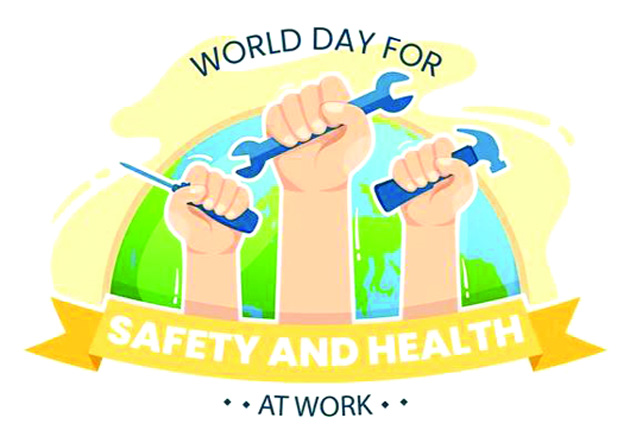D K Pandita
Every year, more than 1 million people die as a result of workplace accidents or exposure to hazardous substances. Another 160 million are injured, and many more suffer from work-related illnesses. These statistics are staggering, but they only tell part of the story. For every life lost or ruined by an occupational injury or disease, there are countless families who suffer along with the workers. In recognition of this fact, the International Labor Organization (ILO) established World Day for Safety and Health at Work in 2003.In June 2022, the International Labor Conference (ILC) decided to include “a safe and healthy working environment” in its framework of fundamental principles and rights at work.
In 2020, there were around 476.67 million workers in India, the second largest after China. Out of which, agriculture consist of 41.19%, industry sector consist of 26.18% and service sector consist 32.33% of total labor force. The theme for World Day for Safety and Health at Work, 2023 is “A safe and healthy working environment as a fundamental principle and right at work”. In 2003, the International Labor Organization (ILO) began to observe World Day for Safety and Health at Work in order to stress the prevention of accidents and diseases at work, capitalizing on the ILO’s traditional strengths of tripartism and social dialogue.
One of the main pillars of the Global Strategy is advocacy. The World Day for Safety and Health at Work is a significant tool to raise awareness of how to make work safe and healthy and of the need to raise the political profile of occupational safety and health. 28 April is also the International Commemoration Day for Dead and Injured Workers organized worldwide by the Trade Union Movement since 1996 for prevention of occupational accidents and diseases.
Each year, the United Nations highlights the importance of preventing accidents and diseases in the workplace, and provides resources and support to help organizations around the world make their workplaces safer and healthier. We have an essential responsibility to ensure that people go to work and come home alive, uninjured, and healthy. This year, on World Day for Safety and Health at Work, we can celebrate an important step towards this goal: the designation of a safe and healthy working environment as a fundamental principle and right at work.
Occupational accidents and diseases lead to devastating impacts on workers, enterprises and entire communities and economies. Despite many improvements, the prevention of accidents and work-related diseases continues to have a considerable importance on a global scale. Cleanliness is important in our life as well as for the nation. It is well known that the Mahatma Gandhi personally took the effort to achieve the change that he wanted to see.
In today’s world, the role of social media is important to create awareness among the people and inculcate a feeling of nationality among them. Cleanliness and safety are not only the responsibility of the ‘safaai kaamgar’ (sanitation worker) or local government. It is the responsibility of all Indians. It is the responsibility of the Government officers, NGOs and the local community to make India completely safe and clean. It’s a need of the present; all the people should actively participate to make the places of work safe and clean India and to fulfill the dream of Mahatma Gandhi for the protection of the environment, for our safety, and for a healthy future.
There are a number of steps that should be taken to develop healthy working environment at businesses and work places to ensure a safe and healthy working conditions. First, it is important to have policies and procedures in place to minimize risks. This may include ensuring that all equipment is properly maintained and that dangerous materials are stored safely. Second, businesses should provide employees with the training and resources they need to stay safe. This might include safety manuals, first aid kits, and regular safety briefings.
Finally, businesses should create a culture of safety by encouraging employees to report hazards and near misses. This can be easily done with the help of software and/or applications for workplace safety. By taking these steps, businesses can create a safe and healthy workplace for everyone who works there. New and emerging occupational risks may be caused by technical innovation or by social or organizational change, such as: New technologies and production processes, e.g. nanotechnology, biotechnology, new working conditions, e.g. higher workloads, work intensification from downsizing, poor conditions associated with migration for work, jobs in the informal economy, emerging forms of employment, e.g. self-employment, outsourcing, temporary contracts.
Trending Now
E-Paper


